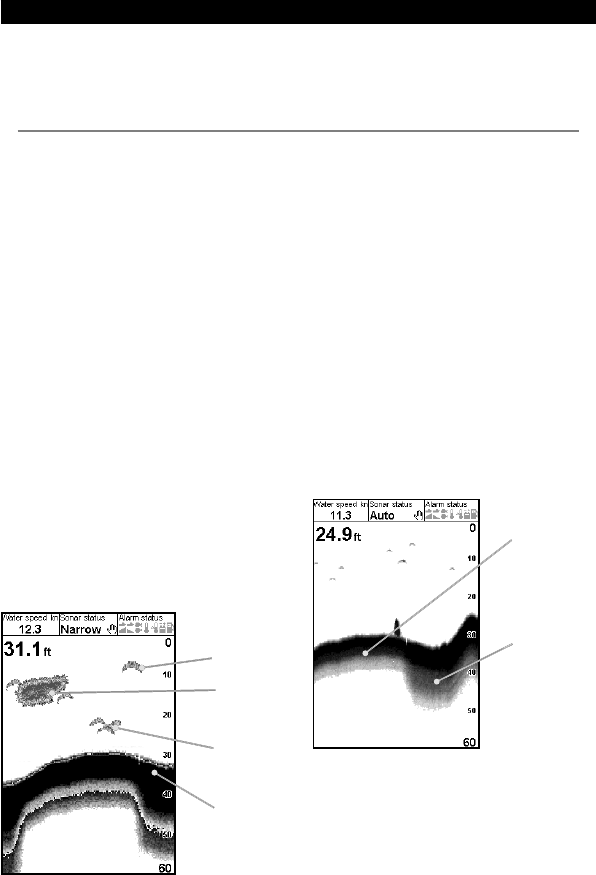
4-1 Interpreting the display
The sonar displays do not show a fixed distance
travelled by the boat; rather, they display a
history, showing what has passed below the
boat during a certain period of time.
The history of the sonar signal displayed
depends on the depth of the water and the
scroll speed setting.
In shallow water, the echoes have a short
distance to travel between the bottom and the
boat. In deep water, the history moves across
the display more slowly because the echoes
take longer to travel between the bottom and
the boat. For example, when the scroll speed is
set to Fast, at depths over 600ft it takes about
2.5 minutes for each vertical line of pixels to
move across the display, whereas at 20ft it
takes only about 4-5 seconds.
The scroll speed can be set by the user to
display either a longer history with less fish
information or a shorter history with more fish
details. See section 3-2 Setup > Sonar.
If the boat is anchored, the echoes all come
from the same area of bottom. This produces a
flat bottom trace on the display.
The screen shot shows a typical sonar display
with the Fish symbols turned Off.
Large
school of
fish
Strength of echoes
The colors indicate differences in the strength
of the echo. The strength varies with several
factors, such as the:
• Size of the fish, school of fish or other object.
• Depth of the fish or object.
• Location of the fish or object. (The area
covered by the ultrasonic pulse is a rough
cone shape and the echoes are strongest in
the middle.)
• Clarity of water. Particles or air in the water
reduce the strength of the echo.
• Composition or density of the object or
bottom.
Note: Planing hulls at speed produce air bubbles
and turbulent water that bombard the transducer.
The resulting ultrasonic noise may be picked up by
the transducer and obscure the real echoes.
4 Using the FISH 4432/4433
This section explains how to interpret the sonar
displays, when and why to use the different
frequencies and how fish are detected
and displayed.
Single fish
Hard bottoms
such as rock
or coral
show as wide
bands
Soft bottoms
such as mud,
weed and
sand show
as narrow
bands
Bottom types
Mud, weed and sandy bottoms tend to weaken
and scatter the sonar pulse, resulting in a weak
echo. Hard, rocky or coral bottoms reflect the
pulse, resulting in a strong echo. See section
5-3 Sonar Bottom display.
Small school
of fish
Bottom
It also describes Gain and Range and shows
examples of some of the different sonar
displays. Also see section 1-2 How the FISH
4432/4433 works.
FISH 4432/4433 Installation and Operation Manual17
NAVMAN


















